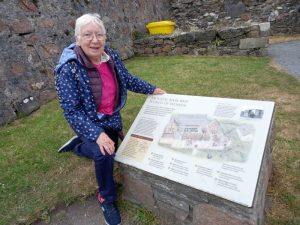Pilgrimage to Iona
by Sr. Rita Kelly MMM Ireland 28.07.2023
 Iona is one of the hundred small islands on the west coast of Scotland. In 563 AD. St Colmcille or Columba from Derry founded a monastery on this remote island. From this monastery Columba and his monks preached the Gospel on the mainland of Scotland and islands. Many churches and monasteries in this part of the world flourished until they were suppressed during the Reformation. I the mid-20th century George McLeod, a Glasgow-based Presbyterian pastor restored the abbey and founded a religious organisation call the Iona Community. The Iona Community, remains in residence as a living and worshipping presence.
Iona is one of the hundred small islands on the west coast of Scotland. In 563 AD. St Colmcille or Columba from Derry founded a monastery on this remote island. From this monastery Columba and his monks preached the Gospel on the mainland of Scotland and islands. Many churches and monasteries in this part of the world flourished until they were suppressed during the Reformation. I the mid-20th century George McLeod, a Glasgow-based Presbyterian pastor restored the abbey and founded a religious organisation call the Iona Community. The Iona Community, remains in residence as a living and worshipping presence.
Iona Island was on my bucket list. As part of a Sabbatical programme in Perth Scotland I had the opportunity fulfil that dream. On the 16th June, twenty participants plus leaders commenced the pilgrimage. Starting with a prayer:
I set out now in pilgrimage,
Leaving aside the clutter and distraction of the world,
To walk in the footsteps of your Son,
To walk in the footsteps of St. Colmcille.
The pilgrimage commenced with a bus journey from Kinnoull, Perth (East Scotland) to Oban (West Scotland). Travelling up mountains and down valleys we marvelled at the wonderful display of God’s Creation. Arriving at the lovely port of Oban, in beautiful sunshine, we headed, by ferry to the Isle of Mull.
Staying overnight in Mull, and setting out early the next morning we travelled by bus across the Isle from Tobermory to Finnphort where there was a shorter ferry journey to Iona. True to form the day was showery, windy and dull. Following the step of St. Columba, our first visit was to the Abbey Church, the foundation of the first monastery. it was also the site of St. Columba’s burial. But during the Vikings invasions of 8th 9th and 10th century, the relics of St. Columba were removed for safety to Kells, Ireland.
As we walked through the island we noticed that many of the stone structures of the Crosses and Churches had the Celtic architectural designs. . On one site I noticed a sign “The World of Women”. It was the ruins of a nunnery built in the 13th Century. A community of nuns lived there whose ministry was to care for abandoned women and children in this remote part of the world.
In all there are twenty-four places where one stops and pray, but the high point of the pilgrimage, p, was the celebration of the Eucharist in the Michael Chapel. After the celebration we pondered on what we sensed was a sacred place, of “oneness” with Columba and his monks, representing different parts of the world: Thailand, Hong Kong, Singapore, Sri Lanke, Australia, Nigeria, Kenya, England, Scotland and Ireland; A global Church with the common vision of sharing the good news. Like the present century St. Columba lived in a trouble world.
To round off of the Pilgrimage we concluded with a prayer of gratitude:
Whenever we g0 –
Let us bring with an awareness of your presence and the joy of your kingdom,
Where you live with your Son and Holy Spirt, one God forever and ever Amen.
SEE ALL BLOG POSTS
